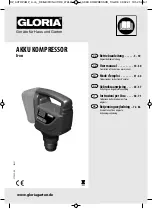
24
3.11.3 Valve Change General Instructions
•
Always replace valves as a complete set.
•
Carefully clean dirty valves. Never use a sharp tool for this purpose. Soak the valves in diesel oil or petro-
leum, and clean with a soft brush.
•
Check individual components for excessive wear. If the valve seat and valve disks are dented, replace the
valves.
•
Valve head screws must be tightened with a torque wrench (See tightening instructions page 23)
•
Check the valve space in the valve heads for dirt, and clean if necessary.
•
Use gaskets and o-rings in reassembly only if they are in satisfactory condition, otherwise replace them.
•
Observe the correct sequence when reassembling.
•
When maintenance work has been completed, turn the compressor manually using the flywheel to verify
correct assembly.
•
30 minutes after restarting the compressor unit, stop the unit, let it cool to ambient temperature, and
retighten the valve studs and cap nuts to specifications (page 23). Otherwise valves could work loose due
to setting of the gaskets.
•
Replace valves every 2000 hours to avoid fatigue failure.
3.11.4 Changing 1st Stage Valves
3.11.4.1 Removal
Intake and pressure valves for the 1st stage are
combined in one plate valve under the valve head,
as seen in the diagram.
1. Remove all tubing connections and lines from
the Valve Head (2).
2. Remove Hex Head Bolts (4) and Washers (3)
3. Remove the Plate Valve (1).
4. Clean Plate Valve, preferably in a ultrasonic
cleaner, and check for damage.
5. Replace worn or damaged parts.
6. Check the underside of the Valve Head for
flatness using a precision straightedge. If
necessary use an emery cloth to smooth out the
surface.
3.11 VALVES
3.11.1 Valve Functioning
The valve heads of the individual stages form the top part of the
cylinders. The intake and pressure valves are fitted inside the
valve heads. Note that the valves are operated by the flow of the
gas. On the suction stroke, the intake valves open and the gas
flows into the cylinders, and on the compression the intake valve
closes, and gas flows out the pressure valve.
3.11.2 Initial Operational Check
After roughly half an hour’s operation, valves should be checked.
Note that the inlet line to the valve heads should be warm, and
outlet piping should be hot. Valves are then shown to be operating
properly.
If the intake pipe to the valve head of the second stage heats up
excessively, and the first stage safety valve blows off, either the
intake or pressure valve of the second stage is malfunctioning. It is
necessary then to remove the valve head and to check and clean these valves or to replace them.
1st Stage Valve Operation
TOP VIEW
Intake Side
Pressure Side
















































